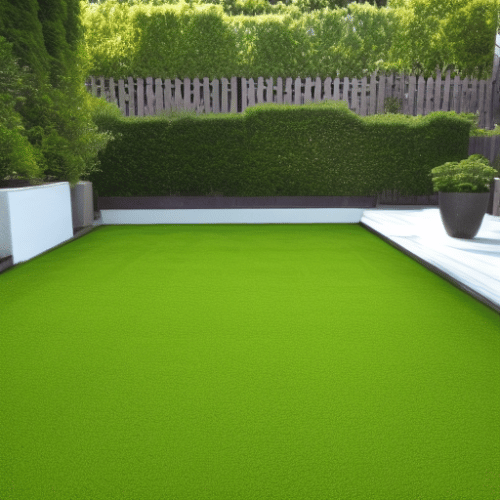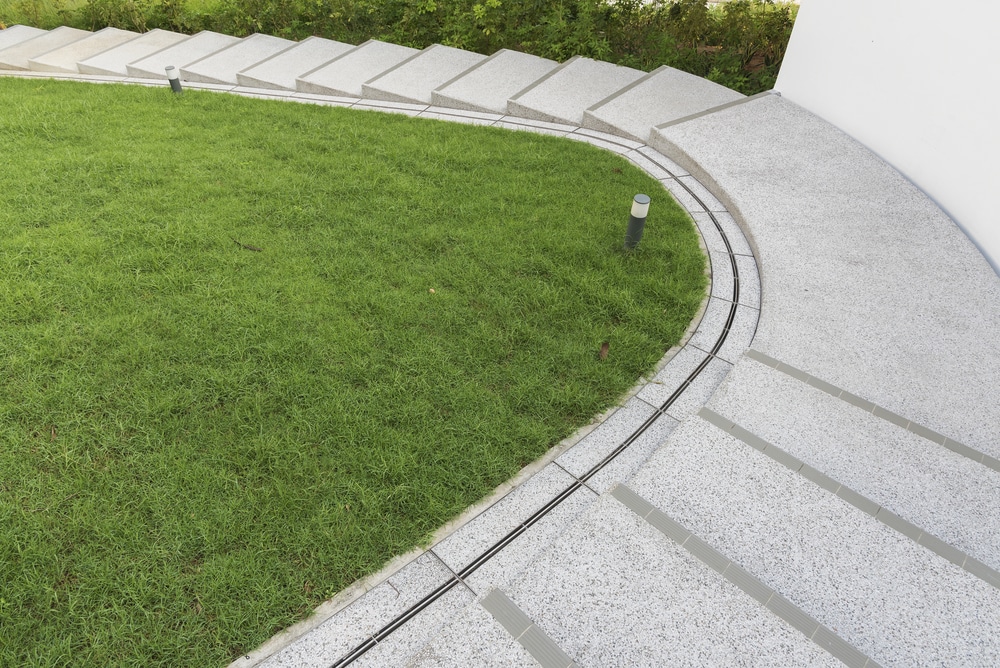Last Updated on
When it comes to artificial grass, you have more options than most people are aware of. You see, people just think about the artificial lawn and how it’s different to natural grass, but there’s more to it than that.
So, what are the different types of artificial grass? Let’s explore this article so that you know what is best for you.
Where You Can Use Artificial Grass
With various types of artificial grass available, Consider the locations where a synthetic lawn will perform better than actual grass.
Areas such as roof gardens can be transformed with an artificial lawn. In an instant, your roof garden can have a splash of green where you will even forget where you are located.
You may also wish to install putting greens on your property. If so, then there are types of artificial grass that will be suitable.
Other artificial grasses can be used for spaces both large and small. Even if you want a splash of colour in your garden, there will be a form of the synthetic turf that will work perfectly.
Different Materials
We’ll start by pointing out the additional materials that can be used with artificial grass before moving on to various pile lengths. It does provide you with a multitude of options, so knowing which option is best for you will be tough without adequate research.
But when you think about it, you need to deal with the same problem as with real grass. There, you have so many varieties of natural grass thanks to the range of seeds, so you face the same issues with fake grass.
Nylon Artificial Grass
Nylon can be a popular choice when it comes to artificial turf. It’s seen as being hard-wearing, which is always important when choosing artificial grass.
This material can withstand high temperatures without the grass, then lose its original shape and create an unnatural-looking lawn. It will also be harder to push the grass down no matter how much it’s being used, and that’s why it’s viewed as being hard-wearing.
Also, nylon is often used as a secondary thatch with other materials. It is to increase the lifespan of cheaper versions of artificial grass. It does push the price up a bit, but as the nylon is only woven through the rest of the lawn, it’s not too expensive.
But there is a problem with pure nylon. It’s expensive compared to other artificial grass options, so people don’t often go for this solution around their homes. However, if you want a putting green at your home, then this would be ideal.
Polyethene Artificial Turf
Another option is polyethene artificial turf, and this version is far more common thanks to it being a less expensive option.
This version does tend to offer quite dense grass, and this fake turf also provides a real splash of colour. Also, as artificial lawns go, polyethene artificial grass is softer to the touch compared to other artificial grass options.
Aside from it being a natural-looking artificial grass, remember to look for a version that also contains nylon as the secondary thatch. That’s going to allow your artificial turf to last longer without it starting to look past its best.
Benefits
Keeping artificial grass clean is something you need to do regularly, so don’t think installing artificial grass means no maintenance. Thankfully, polyethene is the best artificial grass for removing debris from between the blades.
This is thanks to the softness of the blades, so any debris will pop right up without any problems.
Another bonus is that this version won’t hold onto odours. Nylon is not able to do this, so if you have pets, then their urine will smell. This type of artificial grass can be washed with ease, and the smells won’t hang around.
Polypropylene Artificial Grass
Polypropylene artificial grass is the cheapest option out there, and there are times when you can see that it’s a poorer quality synthetic grass. At the same time, you want to know when trying to install artificial grass that it’s durable, and this version is perhaps the least durable on the market.
In saying that, if you still want artificial turf and you are on a budget, then still check it out.
Warnings About Polypropylene
If you want synthetic grass to look real, then this version won’t be for you. It cannot withstand extreme temperatures before the grass blades start to look past their best. The fact it’s not as durable does mean it will look pressed down and damaged in a short time.
If you have children playing or pets, this material is not cost-effective simply because of how often it needs to be replaced.
Pile Height
So, those are the three materials used for artificial grass, but you also need to consider the pile height.
Short Pile
The short pile does have a role to play with artificial grass, but don’t go less than 30mm. If you do, then your artificial grass is going to look less like a real lawn.
However, if you have pets, then a short pile works best for dealing with their waste. It’s easier to rinse their urine out of the grass while it’s nice and soft on their paws.
You may also want to use a short pile of artificial grass if you wish to install a putting green at your home.
Medium Pile
The medium pile is the most common on the market, and it will vary from 30mm to 37mm, and those small differences in size can make a huge change in how your new grass will look.
This height does mean your synthetic turf is going to have a more natural look. It’s denser than the shorter version without appearing overgrown. In a way, this makes it appear more like natural grass.
The medium pile will be the ideal artificial turf for anybody who will be using their artificial lawn throughout the year. Children playing on it, and having friends visiting, this is the best artificial grass to have as it will keep its original shape even on hot summer days.
Longer Pile
The longer pile comes with their own set of problems, and there are several things to be aware of if you do go ahead and purchase this type of artificial grass.
The longer pile tends to appear heavy and dense. It will appear too dense for most gardens, which will often lead to the grass looking very flat. While it all comes down to personal taste, a longer pile will not help you get that natural look.
Consider The Use of Your Artificial Lawn
Aside from the material and length, you need to consider what you will be doing on your artificial grass to help with the decision process. This is a surface you want to be used year-round, so make sure that you get the correct artificial grass for your needs.
You will be using your outdoor space regularly. Well, that’s what we hope for, so look at the maintenance aspect and how durable it is. We mentioned two types above that would work in your garden. But also consider whether you have kids and pets that will be using it or whether you have pathways to direct people away from the grass.
Your Home Lawn
But let’s continue with the idea of installing this type of turf in your garden. It is clearly easier to maintain and will save time in the long run when compared to the real thing. It stays green year-round, and the newer versions do look far more natural than artificial lawns from years ago.
Your home turf should use a medium-length pile with a nice, luscious green colour to get the best look. Find one with nylon woven through since this makes it more durable, and your garden turf will look its best for years to come.
A Pet Area
We mentioned them earlier, but as so many of us are pet owners, offering a recap on the type of artificial turf you should have in your garden is important. You need to be able to maintain and clean the turf regularly when you have pets. Also, you need it to be soft as some longer pile turf is harsher on the skin.
A shorter pile, which is still durable, will work best. It doesn’t have to come at a high cost, and you can easily install it in smaller spaces to provide your pet with a clear place to go.
Trying to Maintain Your Turf

You want your garden always to look amazing, so briefly running over how to maintain your turf is going to help. A longer pile is harder to deal with, and we would largely recommend avoiding this as an option.
So, that leaves a lawn with either a shorter or medium pile, and both can be maintained in the same manner.
Brushing Your Artificial Turf
You need to consider brushing your artificial turf regularly. It helps it look clean and tidy while brushing against the blades to help them stand up.
It works well when your turf is being used on a regular basis. It provides the blades with a springy feel, while it does look more natural as a result.
Rinsing Your Turf
Rinse your turf regularly, and this is important when you have pets. Stains and marks can be washed out with some washing-up liquid and water, which applies even to oil.
Treat the stains as you would do with flooring. Act as quickly as possible to keep your lawn looking perfect. It applies to not only athletic fields but your back garden. All sorts of things can land on your grass, so while it does offer less maintenance than a normal grass lawn, you will still be required to go ahead and look after it to a certain degree.
Avoid Harsh Chemicals
While the nylon version is tougher, you should always avoid harsh chemicals on your turf. You want to preserve the colour as best you can, and harsh chemicals can strip away some of that colour and leave your new turf looking bleached and less appealing.
It applies to both cleaning materials as well as weed killer. Keep using chemicals in a small area, and try to use more natural solutions wherever possible.
Making Your Final Decision
So, how do you make your final decision? Think about your budget, how often you will be walking on your grass, and how much maintenance you want to carry out.
Remember, you can have artificial grass that is soft to the touch, denser, and the perfect colour, and it won’t fade even in the winter. Size up the area to be covered and purchase the best quality turf you can afford. It will work out cheaper over a longer period as you won’t need to keep on replacing the turf when it’s damaged by overuse or even high temperatures.
So, what are the different types of artificial grass? Once you know the answer to this question, you can make the right decision for you and your garden and enjoy it for years to come.
Paul is the type of person who never met a problem he couldn’t fix. He can always be found tinkering with something in his house, even if it isn’t broken! His tips and tricks are often shared on our site. He’s the one you call when something breaks because he has been known to improvise fixes for everything from leaky faucets to malfunctioning dryers.



